Abstract
We have studied the expression of Fc gamma receptors and leucocyte integrins (CD11/CD18 family) on human eosinophils using specific monoclonal antibodies (mAb) and flow cytometric analysis. Peripheral blood eosinophils of normal density and low density were compared with neutrophils and monocytes. Several properties of the human eosinophil were established. These were (i) that the eosinophil expressed Fc gamma RII (CDw32) only (unlike monocytes which bear Fc gamma RI and Fc gamma RII and neutrophils which bear Fc gamma RII and Fc gamma RIII); (ii) that the absence of Fc gamma RIII (CD16) on eosinophils served as a basis for distinguishing eosinophil and neutrophil populations by immunofluorescence; (iii) that the leucocyte adhesion glycoproteins, LFA-1 alpha (CD11a), CR3-alpha (CD11b), p150, 95-alpha (CD11c) and the common beta-chain (CD18), were expressed on the eosinophil as well as the neutrophil; (iv) that CD18 expression was significantly reduced on low-density eosinophils from the hypereosinophilic syndrome. Thus, our findings emphasize the unique phenotype of the human eosinophil in terms of Fc gamma receptor expression, the similarity of the eosinophil and neutrophil with regard to the leucocyte integrins and that eosinophils of low density do not differ greatly from those of normal density in terms of receptor expression.
Full text
PDF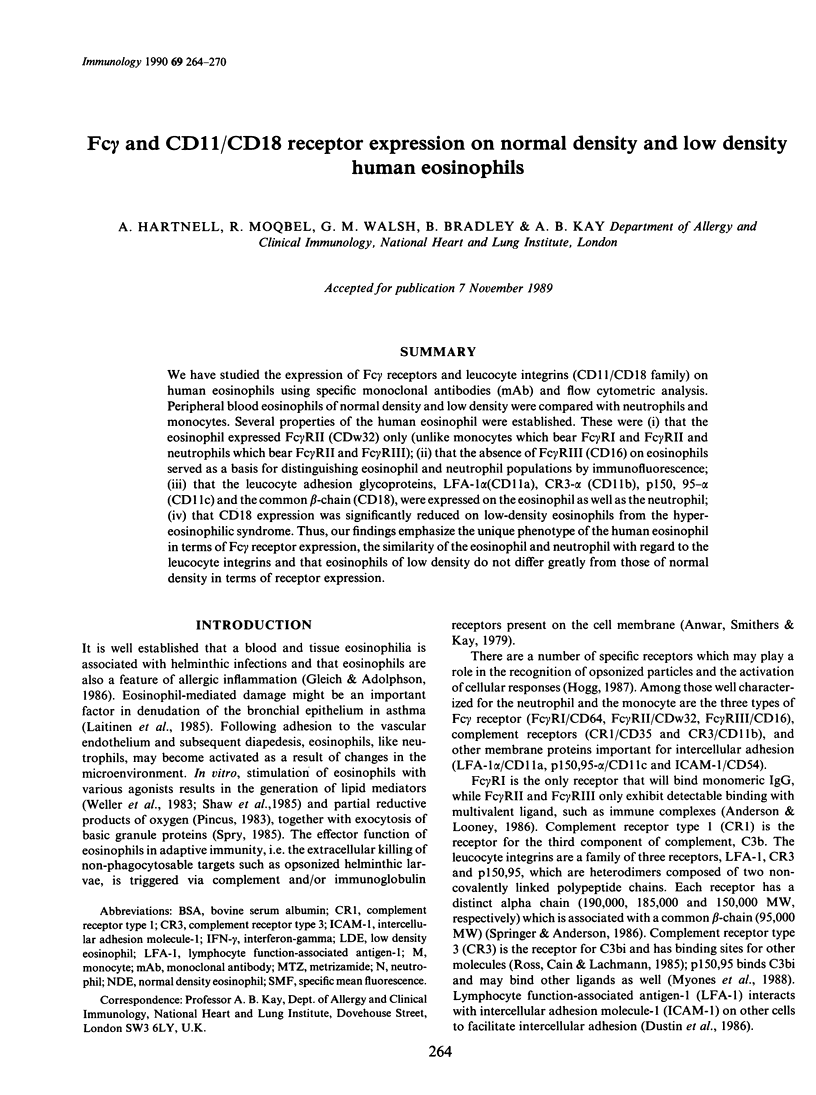
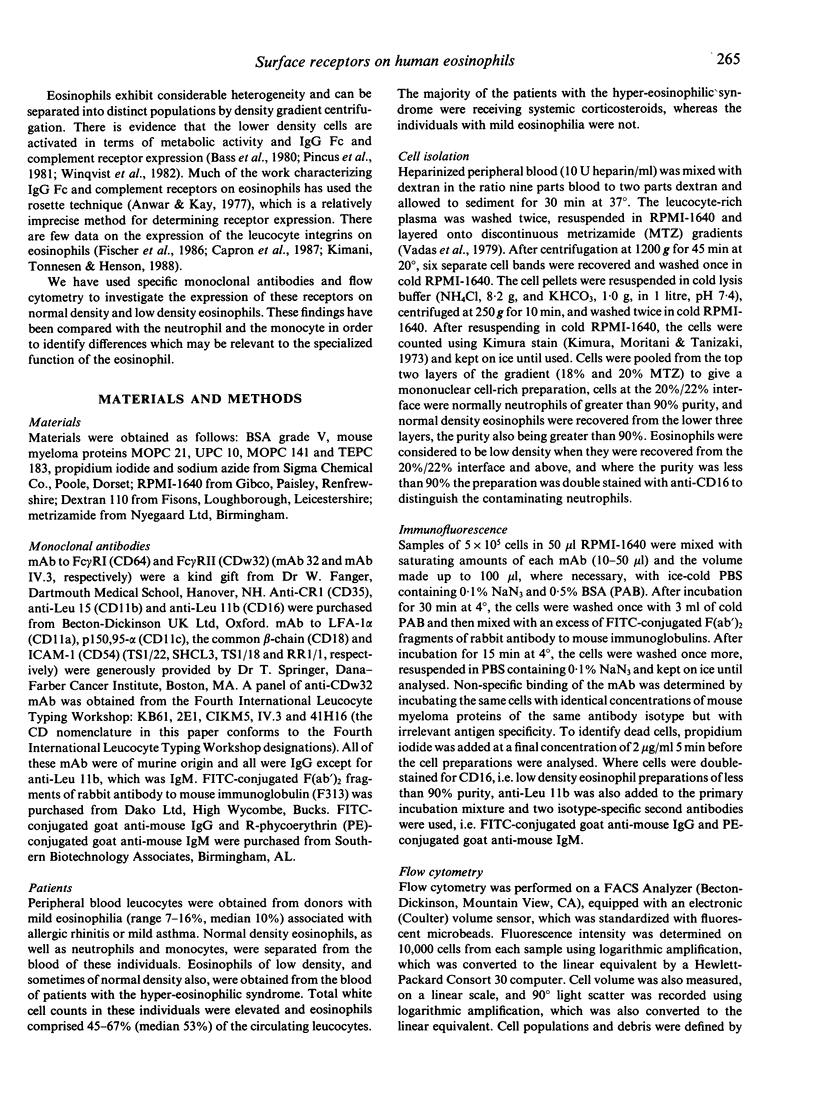
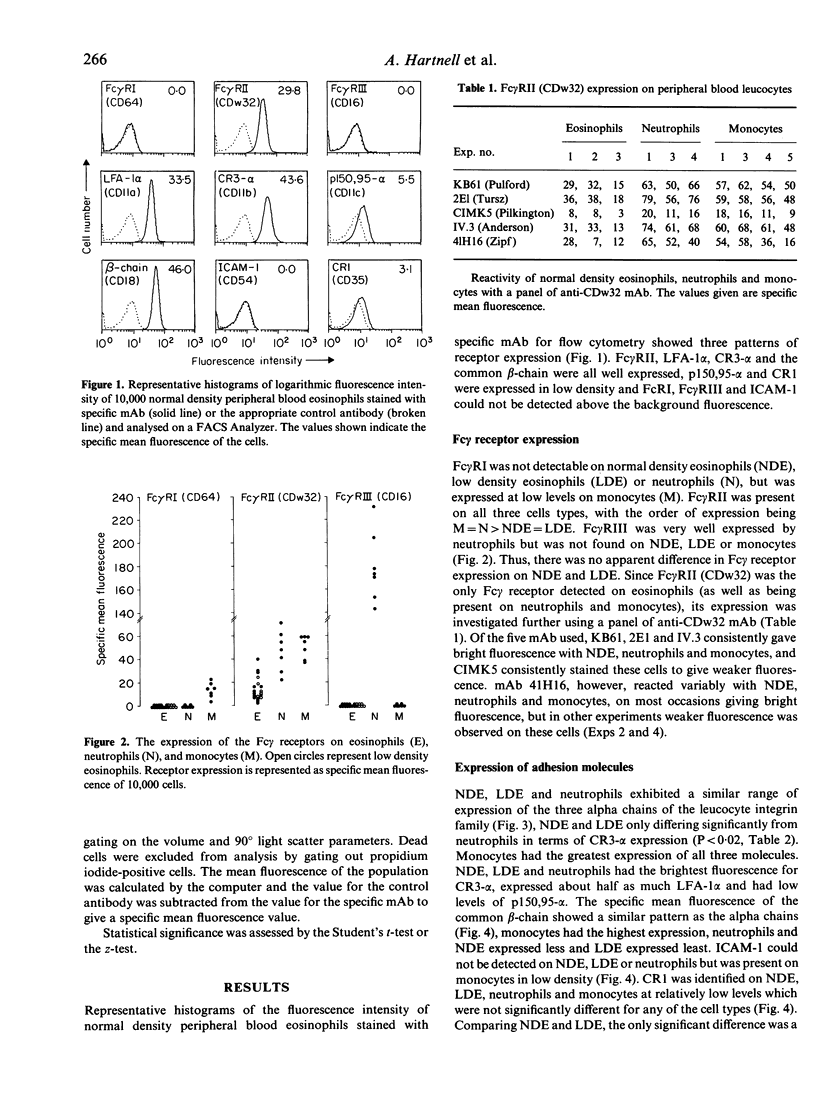
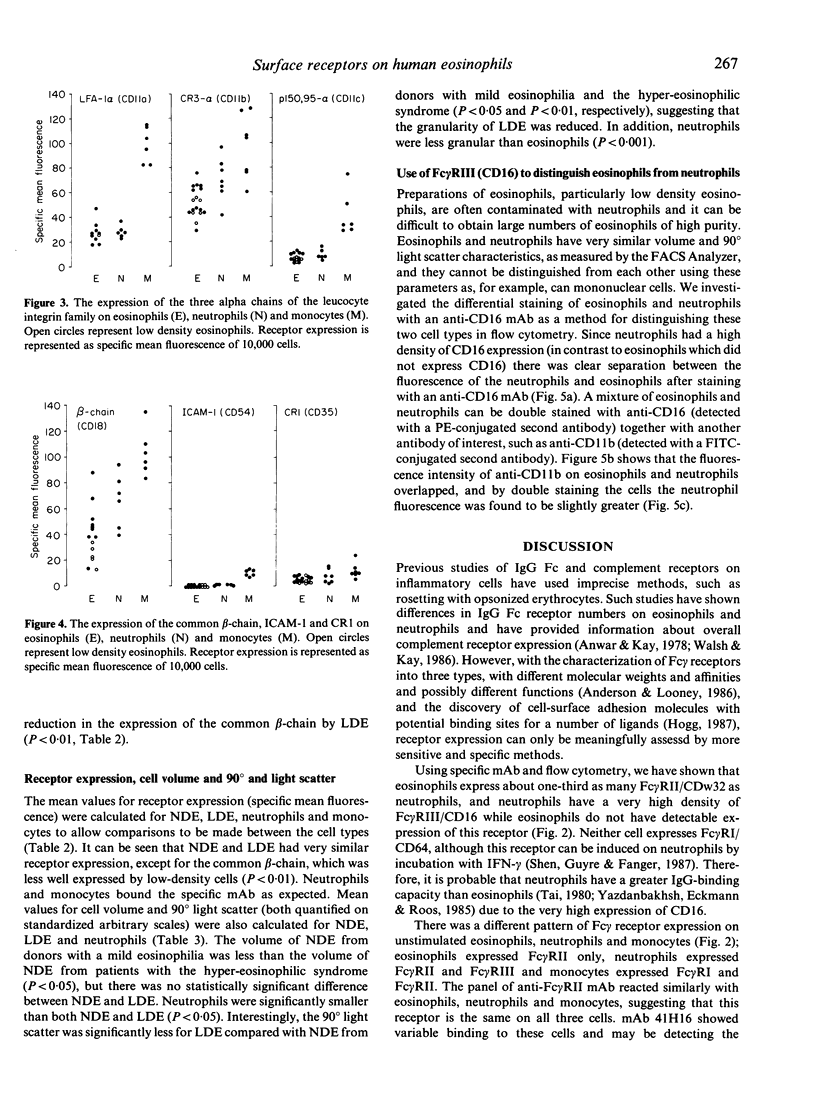
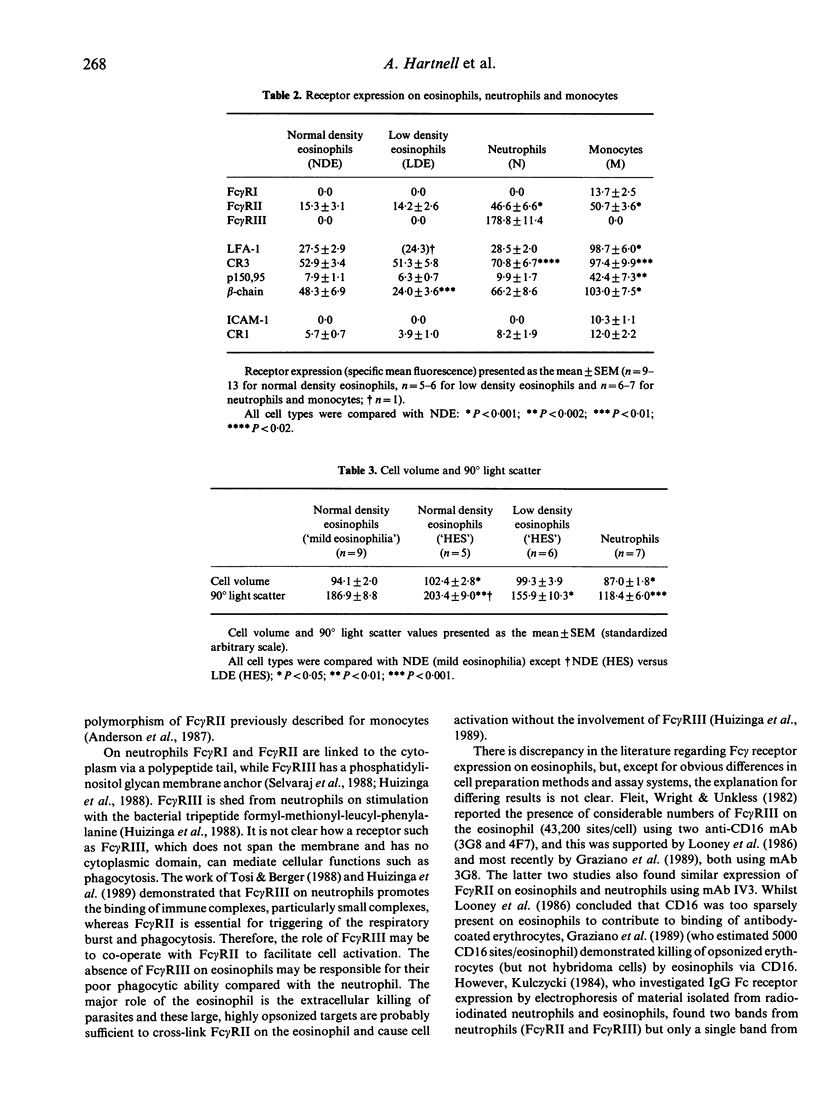
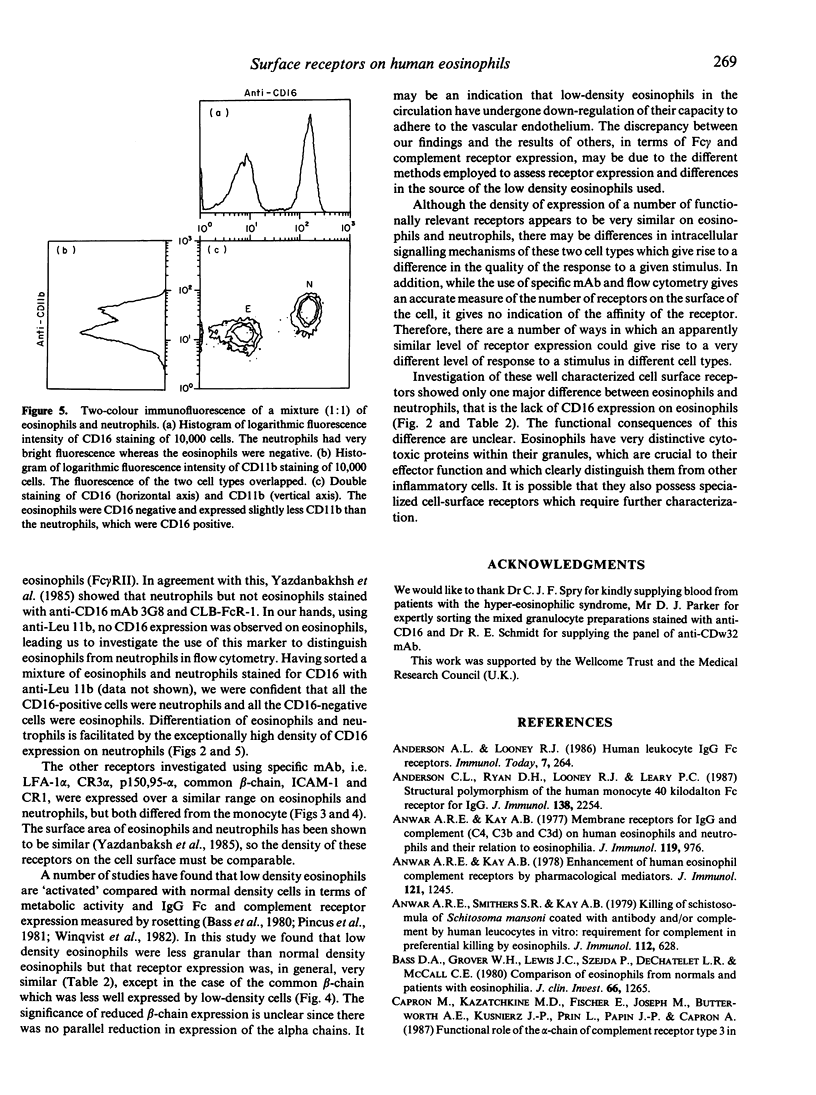
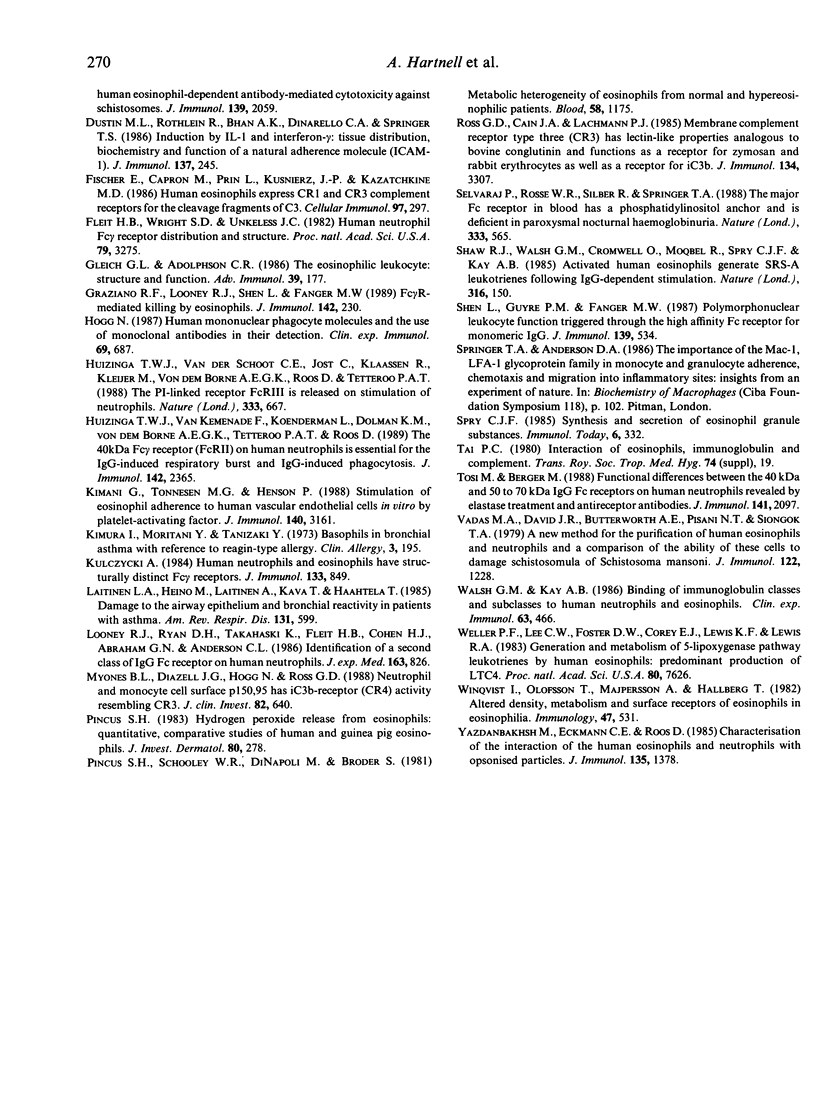
Selected References
These references are in PubMed. This may not be the complete list of references from this article.
- Anderson C. L., Ryan D. H., Looney R. J., Leary P. C. Structural polymorphism of the human monocyte 40 kilodalton Fc receptor for IgG. J Immunol. 1987 Apr 1;138(7):2254–2256. [PubMed] [Google Scholar]
- Anwar A. R., Kay A. B. Membrane receptors for IgG and complement (C4, C3b and C3d) on human eosinophils and neutrophils and their relation to eosinophilia. J Immunol. 1977 Sep;119(3):976–982. [PubMed] [Google Scholar]
- Anwar A. R., Kay B. Enhancement of human eosinophil complement receptors by pharmacologic mediators. J Immunol. 1978 Oct;121(4):1245–1250. [PubMed] [Google Scholar]
- Anwar A. R., Smithers S. R., Kay A. B. Killing of schistosomula of Schistosoma mansoni coated with antibody and/or complement by human leukocytes in vitro: requirement for complement in preferential killing by eosinophils. J Immunol. 1979 Feb;122(2):628–637. [PubMed] [Google Scholar]
- Bass D. A., Grover W. H., Lewis J. C., Szejda P., DeChatelet L. R., McCall C. E. Comparison of human eosinophils from normals and patients with eosinophilia. J Clin Invest. 1980 Dec;66(6):1265–1273. doi: 10.1172/JCI109978. [DOI] [PMC free article] [PubMed] [Google Scholar]
- Capron M., Kazatchkine M. D., Fischer E., Joseph M., Butterworth A. E., Kusnierz J. P., Prin L., Papin J. P., Capron A. Functional role of the alpha-chain of complement receptor type 3 in human eosinophil-dependent antibody-mediated cytotoxicity against schistosomes. J Immunol. 1987 Sep 15;139(6):2059–2065. [PubMed] [Google Scholar]
- Dustin M. L., Rothlein R., Bhan A. K., Dinarello C. A., Springer T. A. Induction by IL 1 and interferon-gamma: tissue distribution, biochemistry, and function of a natural adherence molecule (ICAM-1). J Immunol. 1986 Jul 1;137(1):245–254. [PubMed] [Google Scholar]
- Fischer E., Capron M., Prin L., Kusnierz J. P., Kazatchkine M. D. Human eosinophils express CR1 and CR3 complement receptors for cleavage fragments of C3. Cell Immunol. 1986 Feb;97(2):297–306. doi: 10.1016/0008-8749(86)90400-4. [DOI] [PubMed] [Google Scholar]
- Fleit H. B., Wright S. D., Unkeless J. C. Human neutrophil Fc gamma receptor distribution and structure. Proc Natl Acad Sci U S A. 1982 May;79(10):3275–3279. doi: 10.1073/pnas.79.10.3275. [DOI] [PMC free article] [PubMed] [Google Scholar]
- Gleich G. J., Adolphson C. R. The eosinophilic leukocyte: structure and function. Adv Immunol. 1986;39:177–253. doi: 10.1016/s0065-2776(08)60351-x. [DOI] [PubMed] [Google Scholar]
- Graziano R. F., Looney R. J., Shen L., Fanger M. W. Fc gamma R-mediated killing by eosinophils. J Immunol. 1989 Jan 1;142(1):230–235. [PubMed] [Google Scholar]
- Hogg N. Human mononuclear phagocyte molecules and the use of monoclonal antibodies in their detection. Clin Exp Immunol. 1987 Sep;69(3):687–694. [PMC free article] [PubMed] [Google Scholar]
- Huizinga T. W., van Kemenade F., Koenderman L., Dolman K. M., von dem Borne A. E., Tetteroo P. A., Roos D. The 40-kDa Fc gamma receptor (FcRII) on human neutrophils is essential for the IgG-induced respiratory burst and IgG-induced phagocytosis. J Immunol. 1989 Apr 1;142(7):2365–2369. [PubMed] [Google Scholar]
- Huizinga T. W., van der Schoot C. E., Jost C., Klaassen R., Kleijer M., von dem Borne A. E., Roos D., Tetteroo P. A. The PI-linked receptor FcRIII is released on stimulation of neutrophils. Nature. 1988 Jun 16;333(6174):667–669. doi: 10.1038/333667a0. [DOI] [PubMed] [Google Scholar]
- Kimani G., Tonnesen M. G., Henson P. M. Stimulation of eosinophil adherence to human vascular endothelial cells in vitro by platelet-activating factor. J Immunol. 1988 May 1;140(9):3161–3166. [PubMed] [Google Scholar]
- Kimura I., Moritani Y., Tanizaki Y. Basophils in bronchial asthma with reference to reagin-type allergy. Clin Allergy. 1973 Jun;3(2):195–202. doi: 10.1111/j.1365-2222.1973.tb01321.x. [DOI] [PubMed] [Google Scholar]
- Kulczycki A., Jr Human neutrophils and eosinophils have structurally distinct Fc gamma receptors. J Immunol. 1984 Aug;133(2):849–854. [PubMed] [Google Scholar]
- Laitinen L. A., Heino M., Laitinen A., Kava T., Haahtela T. Damage of the airway epithelium and bronchial reactivity in patients with asthma. Am Rev Respir Dis. 1985 Apr;131(4):599–606. doi: 10.1164/arrd.1985.131.4.599. [DOI] [PubMed] [Google Scholar]
- Looney R. J., Ryan D. H., Takahashi K., Fleit H. B., Cohen H. J., Abraham G. N., Anderson C. L. Identification of a second class of IgG Fc receptors on human neutrophils. A 40 kilodalton molecule also found on eosinophils. J Exp Med. 1986 Apr 1;163(4):826–836. doi: 10.1084/jem.163.4.826. [DOI] [PMC free article] [PubMed] [Google Scholar]
- Myones B. L., Dalzell J. G., Hogg N., Ross G. D. Neutrophil and monocyte cell surface p150,95 has iC3b-receptor (CR4) activity resembling CR3. J Clin Invest. 1988 Aug;82(2):640–651. doi: 10.1172/JCI113643. [DOI] [PMC free article] [PubMed] [Google Scholar]
- Pincus S. H. Hydrogen peroxide release from eosinophils: quantitative, comparative studies of human and guinea pig eosinophils. J Invest Dermatol. 1983 Apr;80(4):278–281. doi: 10.1111/1523-1747.ep12534646. [DOI] [PubMed] [Google Scholar]
- Pincus S. H., Schooley W. R., DiNapoli A. M., Broder S. Metabolic heterogeneity of eosinophils from normal and hypereosinophilic patients. Blood. 1981 Dec;58(6):1175–1181. [PubMed] [Google Scholar]
- Ross G. D., Cain J. A., Lachmann P. J. Membrane complement receptor type three (CR3) has lectin-like properties analogous to bovine conglutinin as functions as a receptor for zymosan and rabbit erythrocytes as well as a receptor for iC3b. J Immunol. 1985 May;134(5):3307–3315. [PubMed] [Google Scholar]
- Selvaraj P., Rosse W. F., Silber R., Springer T. A. The major Fc receptor in blood has a phosphatidylinositol anchor and is deficient in paroxysmal nocturnal haemoglobinuria. Nature. 1988 Jun 9;333(6173):565–567. doi: 10.1038/333565a0. [DOI] [PubMed] [Google Scholar]
- Shaw R. J., Walsh G. M., Cromwell O., Moqbel R., Spry C. J., Kay A. B. Activated human eosinophils generate SRS-A leukotrienes following IgG-dependent stimulation. Nature. 1985 Jul 11;316(6024):150–152. doi: 10.1038/316150a0. [DOI] [PubMed] [Google Scholar]
- Shen L., Guyre P. M., Fanger M. W. Polymorphonuclear leukocyte function triggered through the high affinity Fc receptor for monomeric IgG. J Immunol. 1987 Jul 15;139(2):534–538. [PubMed] [Google Scholar]
- Springer T. A., Anderson D. C. The importance of the Mac-1, LFA-1 glycoprotein family in monocyte and granulocyte adherence, chemotaxis, and migration into inflammatory sites: insights from an experiment of nature. Ciba Found Symp. 1986;118:102–126. doi: 10.1002/9780470720998.ch8. [DOI] [PubMed] [Google Scholar]
- Tosi M. F., Berger M. Functional differences between the 40 kDa and 50 to 70 kDa IgG Fc receptors on human neutrophils revealed by elastase treatment and antireceptor antibodies. J Immunol. 1988 Sep 15;141(6):2097–2103. [PubMed] [Google Scholar]
- Vadas M. A., David J. R., Butterworth A., Pisani N. T., Siongok T. A. A new method for the purification of human eosinophils and neutrophils, and a comparison of the ability of these cells to damage schistosomula of Schistosoma mansoni. J Immunol. 1979 Apr;122(4):1228–1236. [PubMed] [Google Scholar]
- Walsh G. M., Kay A. B. Binding of immunoglobulin classes and subclasses to human neutrophils and eosinophils. Clin Exp Immunol. 1986 Feb;63(2):466–472. [PMC free article] [PubMed] [Google Scholar]
- Weller P. F., Lee C. W., Foster D. W., Corey E. J., Austen K. F., Lewis R. A. Generation and metabolism of 5-lipoxygenase pathway leukotrienes by human eosinophils: predominant production of leukotriene C4. Proc Natl Acad Sci U S A. 1983 Dec;80(24):7626–7630. doi: 10.1073/pnas.80.24.7626. [DOI] [PMC free article] [PubMed] [Google Scholar]
- Winqvist I., Olofsson T., Olsson I., Persson A. M., Hallberg T. Altered density, metabolism and surface receptors of eosinophils in eosinophilia. Immunology. 1982 Nov;47(3):531–539. [PMC free article] [PubMed] [Google Scholar]
- Yazdanbakhsh M., Eckmann C. M., Roos D. Characterization of the interaction of human eosinophils and neutrophils with opsonized particles. J Immunol. 1985 Aug;135(2):1378–1384. [PubMed] [Google Scholar]


